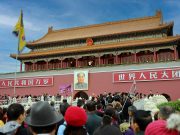(Singapore, 02.10.2025)From openly mimicking the iPhone 17 in naming its newest smartphone Xiaomi 17, to touting “higher output without higher prices” in a market response move echoing Apple, Xiaomi is now being mocked in China for attempting to excel at everything while standing out at nothing, Chinese media report.
And it also seems destined never to outshine Apple lacking the spark of a trend-setter or industry disrupter, Chinese online commentators remarked.

The Xiaomi 17 series — comprising the standard 17, 17 Pro, and 17 Pro Max — officially launched in China on September 25. During the event, Xiaomi founder, chairman, and CEO Lei Jun mentioned Apple repeatedly, drawing numerous comparisons between the Xiaomi 17 and the iPhone 17. Many online commentators quipped that the event appeared to focus more on Apple than on Xiaomi itself.
Xiaomi is a Chinese electronics company primarily recognized for its smartphones, but its products extend far beyond, encompassing smart home devices, laptops, tablets, and electric vehicles.
Despite the hype surrounding the Xiaomi 17’s new features, the spotlight at its launch fell on the series’ name, which openly signalled Xiaomi’s intention to benchmark it against the iPhone 17. Many Xiaomi users asked: the company released the Xiaomi 15 series last year, so why skipped the 16 and jumped straight to 17? noted the Chief Business Review.
Lei did anticipate the question, asserting, “People may need to take a fresh look at Xiaomi phones. This edition marks a major leap forward—truly impressive. In many ways, it even outshines the entire iPhone 17 series,” reported the Review, a financial media outlet specializing in business insights and value creation.
The Xiaomi 17 might eclipse the iPhone 17, but must it mirror Apple so overtly in its naming? With the launch of the Xiaomi 17, 17 Pro, and 17 Pro Max, the series have expanded from two models to three for the first time—and this time the names are confusing, the Review pointed out.
However, the Review also praised CEO Lei, saying he does know his product users well, and benchmarking really pays off. The Xiaomi 17 series sold out across all models within just five minutes after launch, breaking China’s 2025 domestic smartphone records for first-day sales and revenue across all price segments.
Last year, Xiaomi set the starting price of its 15 series at 4,499 yuan (around S$904), marking a 12.5% increase over the 14 series—a price it has carried over to the 17 series. However, the top-tier 17 models saw an additional 200 – 500 yuan hike, underscoring Xiaomi’s determined push into the premium market.
Raising prices has delivered immediate results. Xiaomi’s financial reports show its smartphone gross margin has risen from roughly 2% in its early years to about 12% over the past three years. However, Apple’s margins has remained a consistent 30–40%, maintaining its industry-leading position. Xiaomi’s goal is evident: mirror Apple’s strategy, develop comparable pricing power, and achieve similar market influence.
However, the day after Lei’s September 25 speech, the market response was muted — Xiaomi’s shares plunged more than 8% at one point, wiping out over HK$100 billion (S$16.6 billion) in market value. With attractive prices and record-breaking sales, why did the capital markets react so negatively? the Review mused.
Tianfeng Securities analyst Kuo Ming-Chi pointed out a major concern: total shipments of the Xiaomi 17 series have been reduced by about 20%. Without additional pricing or marketing measures, the series may lag behind the Xiaomi 15 series.
Kuo points to weaker-than-expected demand for the standard Xiaomi 17 as the main reason for the series’ reduced sales forecast. Originally projected to account for 50–55% of total sales, the standard model ultimately represented only 15–20% after launch. Although orders for the Pro and Pro Max variants have risen, they have not fully offset the shortfall from the standard model.
Wang Hua, general manager of Xiaomi’s PR Department, proclaimed: “There are no plans to reduce projected orders at this time. The introduction of the 16GB+1TB version of the Xiaomi 17 standard model, along with forecast demand for the 17 Pro series, will adjust the product mix. Ultimately, overall production is expected to surpass that of previous editions.”
It remains uncertain whether total sales will increase or decline, but the Xiaomi 17 is expected to lag behind the iPhone 17, which delivers “more units at the same price,” the Review projected. On launch day, iPhone 17 sales reached roughly 185% of the previous model, while the iPhone 17 Pro Max hit about 150%. Over the past week, it has continued to add nearly a million units in new sales, the Review recounted.
Apple continues to dominate China’s high-end smartphone market. However, the competition is intensifying. In Q1 2025, data shows that the iPhone’s share of devices priced above 6,000 yuan fell from 70% to 58%. At the same time, Chinese brands such as OPPO, Vivo, and Xiaomi are increasingly aligning with Apple’s software ecosystem, making it easier for users to migrate from iPhone to Android.
Some netizens questioned acidly, “If Apple has to cut prices this year to maintain sales, what edge does the Xiaomi 17 have to surpass it?”
Xiaomi continues to pursue its goal of being “Apple’s alternative.” In terms of pricing, it pits its top-tier models against Apple’s base model, creating the perception of “high specs at a lower price”. But if Xiaomi has genuinely entered the high-end market, why did it imitate Apple so closely in every detail? the Review wondered.
Meanwhile the iPhone 17’s base model now offers 256GB of storage while retaining the launch price of 5,999 yuan. With government subsidies, the effective price on consumers could fall to 5,499 yuan, placing it on par with mid-to-high-end Android devices.
In addition, across the iPhone lineup, a 120Hz high-refresh display is now standard, and even the base model comes with dual-band GPS. The phones also boast upgraded front and rear cameras, larger batteries, and more memory. In short, they cater to the brand’s most devoted customers, swiftly propelling itself back onto the best-seller lists.
Most iPhone sales also continue to be driven by the Pro and Max models, which are not eligible for government subsidies. Apple enthusiasts are always ready to buy Apple —they re simply waiting for the version that fits their needs.
According to the Review, users switching from Apple to Xiaomi are generally price-conscious yet still prioritize high performance. Should Apple start targeting this segment, Xiaomi could face significant challenges.
As remarked by the well-known tech media outlet ifanr: “The Xiaomi 17 seems less focused on leading the industry and more on targeting the ‘largest common denominator’ that appeals to the widest range of users.”
The Xiaomi 17, falling short of hardcore appeal, struggles to showcase Xiaomi’s aspirations for the high-end market. While its technical capabilities are solid, the Review concluded it has yet to show an ability to set industry trends or deliver genuinely groundbreaking innovations.




































